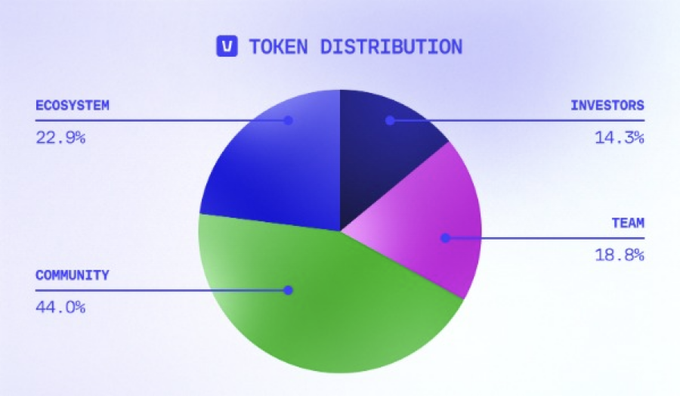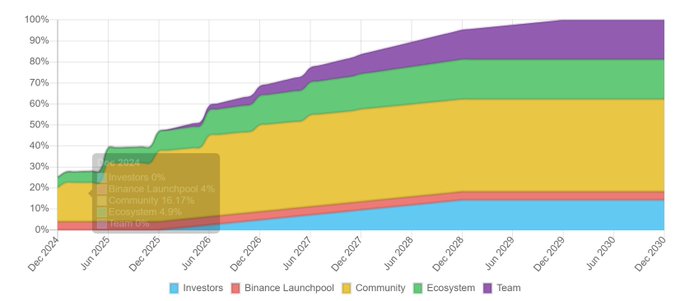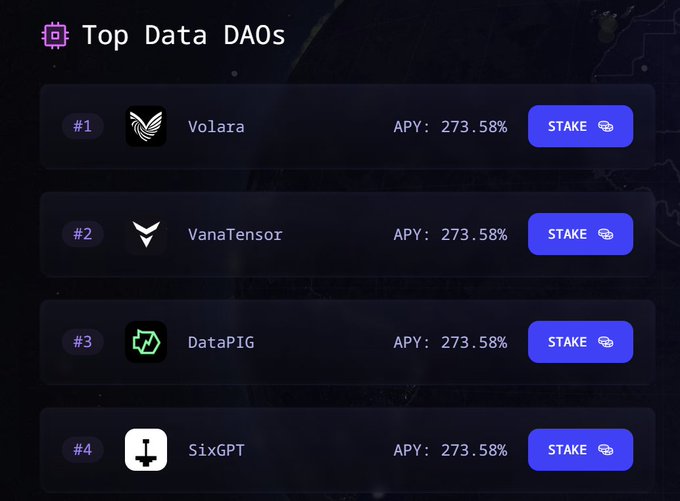An in-depth analysis of the value and participation methods of the AI public chain Vana

Reprinted from chaincatcher
01/02/2025·3MAuthor: Biteye core contributor Jesse
Over the past two decades, personal data has gradually evolved into the core currency of the Internet economy. In the process of enjoying free services, users often unintentionally transfer data control rights to the platform. These platforms have achieved huge economic benefits through targeted advertising and data transactions.
With the rapid development of artificial intelligence technology, private data has become a key resource to promote an AI-driven world. However, there are two significant contradictions in this ecosystem: the producers of data, individuals, often cannot obtain financial returns from it; and AI researchers face difficulties in obtaining high-quality data sets.
The early idea of the Internet was to establish an open ecosystem where users could fully control their own data. However, with the popularization of cloud infrastructure and the convenience of free services, platforms have gradually monopolized the management rights of digital identities and built a centralized data economic system.
This status quo obviously deviates from the original design intention of the Internet.
1. Data ownership and its importance
Today, two forces of change are challenging the existing data monopoly: on the one hand, the rapid development of AI has exponentially increased the value of personal data; on the other hand, the rise of decentralized technology provides a new way for individuals to regain control of their data. tools. Vana is committed to leading this transformation, ushering in a new era of data economy as the first open protocol designed for data sovereignty .
Vana is an EVM-compatible AI public chain that focuses on the management and governance of user sovereign data. Its core goal is to build a distributed network that allows users to not only own and govern the data they contribute, but also directly profit from data capitalization.
Vana not only gives users control over their data, but also provides developers with compliant and high-quality data resources, building a win-win ecosystem.
Vana uses private key authority management to ensure data portability and control, challenge the monopoly of centralized platforms in the Web2 era, build a decentralized data market, eliminate intermediate links, and create fair value for all participants.
User-oriented
-
Data monetization : Vana allows users to extract data from centralized platforms and aggregate it into decentralized data collections. By participating in the decentralized data DAO, users can obtain economic returns from data sharing.
-
Sovereignty and portability : Users not only control data, but can also unlock diverse values, such as personalized AI services or data insights.
For developers and researchers
-
High-quality data access : Vana provides user-owned and transparently governed data sets, significantly improving the efficiency of the data market.
-
AI model optimization : Developers can leverage compliant, portable data sets to drive AI innovation.
Oriented to the overall ecology
-
Efficient data market : Create a fair and efficient data ecosystem through interest alignment and disintermediation.
-
Promote responsible innovation : ensure that data contributors receive fair returns and promote ethical and responsible data use in the AI economy.
Through Vana's technology and ecological design, the value of personal data changes from passive to active. Vana not only challenges the centralized monopoly of the Web2 era and continues the network effect of centralized platforms, but also brings a fairer, more transparent and more efficient future to the data economy.
2. How DataDAO can better empower AI Agent
Unlike traditional digital assets, the economic value of data relies on controlled access . Once data is made public, its market value can quickly depreciate. Traditional blockchain is not suitable for handling private data due to its emphasis on public verification. Vana successfully solves this problem by combining private data hosting with public ownership.
Vana maintains a global state network that ensures transparency in data ownership, quality verification, and revenue distribution. Its core features include:
-
Data ownership record : Cryptographically proves user ownership of data.
-
Access rights management : Define data access conditions and authorization scope.
-
Proof of verification : Ensure data quality, authenticity and metadata integrity.
-
DataDAO contract and token balance on the chain : realizing governance and economic rights distribution.
Data is always encrypted and stored in a secure environment or on the user's personal server, and the platform controls access programmatically and ensures that revenue goes back to the data creator. Users can export their own data, protect it with encryption, and then join a data collective called DataDAO . Through these collectives, users negotiate with researchers or developers about the commercial use of data, ensuring that contributors receive reasonable returns.
Each DataDAO customizes the Proof of Contribution based on its data type and measures the value of the data through the following indicators (including but not limited to):
-
Financial Data : Transaction accuracy, record completeness and consistency.
-
Social media data : user interaction levels, account active time, and content engagement.
-
Health data : data freshness, measurement frequency and device accuracy.
Data verification is accomplished by the Satya network, which consists of Trusted Execution Environments (TEEs) that provide data quality verification while protecting privacy. In addition, some DataDAOs use zero-knowledge proofs (zk-proofs) to further enhance privacy and security.
When developers purchase access to data, contributors receive prorated compensation through governance tokens. This mechanism ensures that data contributors receive ongoing financial returns from data usage. Contributors have decision-making rights and participate in the governance of data use. The data market achieves fair pricing and improves efficiency by incentivizing high-quality data contributions.
Vana provides decentralized and highly liquid Data Liquidity Pools (DLPs) . Users maintain encrypted control over their data while sharing it collectively. Mapping DataDAO's non-homogeneous data into tradable tokens through a smart contract-driven mechanism enables the market-oriented flow of data. This is Vana's innovation in the history of encryption development. Whenever a new tokenized asset appears on the market, market attention and capital simply follow. From a historical perspective, NFT has introduced tokenization into art. The unit prices of artworks such as Boring Monkey and Art Blocks have reached millions of dollars, driving investors crazy. Judging from the innovations of this cycle, Pendle’s tokenization of yields has stimulated the activity of the DeFi market and become the most outstanding performing DeFi protocol in 2024. Pioneers in each asset class enjoy the largest premiums. This new tokenization innovation comes from Vana’s exploration of the potential of unstructured data. This may also be a consideration for major exchanges to launch Vana as soon as possible.
2025 will undoubtedly be the first year of AI Agent. AI Agent will be the next external form of dApp. The implications of this change are similar to the jump we made from desktop to mobile devices over the past decade. But it will happen faster and on a larger scale. Data is the new oil in the AI era. This also makes Vana's story interesting. Because the performance of an AI model directly depends on the quality of its training data, not just the innovation of computing power or model architecture. This reality is redefining priorities for AI development: data quality has become a core bottleneck for AI progress.
AI Agents are facing a common challenge: useless input leads to useless output. Without high-quality training data, even the most sophisticated AI agent cannot truly function. This brings us to the importance of building a trustworthy data foundation.
That's what's so important about Vana. Vana is more than just a regular AI project, it attempts to pave the way for user data ownership and high-quality AI data. Through DataDAO, users can stake
Tokens that support the creation of high-quality datasets. This model incentivizes users to participate in the shaping of AI training data.
For AI Agents, the importance of this mechanism is self-evident: higher quality training data directly translates into more powerful AI performance. The community-driven curation mechanism also ensures the diversity and reliability of data sources, ensuring the sustainability of the model.
Today, ai16z is in the spotlight because of the resource support of a16z behind it, and Virtual has become a popular AI Agent Launchpool with the liquidity of Base. Vana has received a total of US$25 million in financing from top venture capital investors such as Coinbase Venture, Paradigm, and Polychain , and its resources are not inferior to those of ai16z and Virtual. DataDAO built on Vana requires VANA tokens to participate. It is essentially similar to a Launchpool focused on the data track . Investors pledge Vana to the promising DataDAO to support development and receive staking rewards. In the future, these DataDAOs may be airdropped to Vana stakers who support its development (dFusion AI Protocol has announced a 1:1 token airdrop to Vana stakers). Each DataDAO requires a minimum stake of 10,000 $VANA to receive rewards, further promoting Vana deflation. AI Agent is undoubtedly the hottest topic at present, and the most critical input data that affects the performance of AI Agent will also be discovered by investors with market education. By then, Vana's value discovery will have just begun.
Through the innovative design of DataDAO and DLPs, Vana reshapes the infrastructure of the data economy, while promoting the fair circulation of high-quality data and creating a more responsible ecological environment for AI innovation.
3. Vana’s value analysis
In addition to the above discussion about Vana's pioneering tokenized data in Web3, providing high-quality data for AI Agents, and the value of DataDAO Launchpool, you can also jump out of the Web3 framework and look at Vana's positioning in the entire Internet technology ecosystem. a16z partner Justine Moore has published a list of AI projects worthy of attention, and Vana is the only Web3 AI project among them (even though a16z did not invest in Vana).
AI = data + model + computing power. The current model track is an oligopoly competition between Open AI and Anthropic, the computing power track is a monopoly of NVIDIA, and Hyperbolic uses distributed computing power to launch a challenge. The data track is the core and foundation of AI and the new oil in the AI era. Without data, the express train of AI cannot start. At present, no company is in an absolute leading position in the data field.
In the age of the internet, digital footprints reveal more than self-knowledge: Algorithms analyze subtle clues such as Facebook likes or GPS records to predict personality traits, income levels and even mental health more accurately than friends and relatives. Seemingly trivial actions, such as the choice of time to shop or the tone of a social media post, can unintentionally reveal our emotions, preferences, and even deeper truths. Personalized information push based on digital data can more effectively target personality traits, such as helping low-income groups significantly improve their savings ability. Therefore, it is important to tap into the potential of data.
In Web3 projects, owning your data is no longer an attractive topic. How to bring real benefits to users by mining the value of data is what they care about. The profits of Web2 technology companies actually come from the control of data, such as Google's precise advertising and Ant CNC's big data finance. Reddit has made more than $200 million in revenue by selling data from user-generated content to train AI. Many Web2 technology companies are essentially big data companies. Google parent company Alphabet has a market capitalization of 2.39 trillion, Facebook 1.15 trillion, Twitter 55.68 billion, and Reddit 29.6 billion. On Vana's platform, researchers can not only obtain data from Twitter or Reddit, but also obtain high-value sensitive data such as health and finance without violating privacy. With the gradual spread of network effects inspired by tokens, it is foreseeable that Vana will become a source center for high-quality data. More and more researchers will access data from here, and AI will no longer be controlled by a few elites. Vana, which promotes the democratization of AI, is as significant to the transformation of AI as Bitcoin is to traditional finance.
On the other hand, Vana treats unstructured data as tradable financial assets and builds derivatives such as secondary spot markets, lending markets, options and futures contracts around DLP. This has opened up a new asset category in both traditional finance and DeFi. This is not possible on Nasdaq and the Chicago Mercantile Market. Because no Web2 large technology company will revolutionize itself and give away core data profits. Once the data is made public, its value will drop off a cliff or cause privacy issues. Not to mention the complicated KYC process of centralized exchanges. Vana can solve these pain points very well, and currently only Vana can do it. Any new asset usually brings with it a froth of hype, as recent new narratives like DeSci and AI Agent have caused FOMO. The increase in the total market value of DLP will attract new people to care about and participate in these DataDAOs. New users will bring new opinions on how to improve the user experience, improve the operating mechanism of DataDAOs, and make the entire ecosystem more powerful.
The core reason why Silicon Valley has been able to create so many high-value companies that have changed the world lies in its bet on the vision of a better life. Compared with Internet technology companies, Vana is still small, but its mission is huge. Cryptocurrencies give investors around the world the opportunity to participate in early-stage potential projects. The current circulating market value of Vana is only US$500 million.
4. Vana Eco Flywheel
The VANA token is the cornerstone of this economic system, with functions including network security, transaction fees, DLP staking, data access currency, and protocol governance .
When AI businesses access data, they use VANA tokens to purchase and destroy DLP-specific tokens. This burning mechanism establishes a direct economic link between network usage and token value, ensuring that value flows back to data contributors and the broader network ecosystem.
In addition, the incentive structure further drives the adoption of the protocol, such as promoting ecological activity by rewarding DataDAO with outstanding performance. To date, the Vana Foundation has supported 12 active DataDAOs and received over 300 accelerator applications. These DAOs cover diverse application scenarios from Twitter data, synthetic data to genetic data and browser data, demonstrating the broad potential of the Vana protocol.
Vana attaches great importance to the power of the community and has allocated 44% of the tokens to the community, 20.3% of which have been released in TGE. It is one of the few projects in 2024 that will benefit participants significantly in the short term . The tokens allocated to investors will not be unlocked in the first year, and will be unlocked in three years thereafter, further demonstrating investors’ confidence in its technology and model. The team received 18.81% of the tokens, which were locked in the first year and then unlocked in four years. This distribution method ensures that the team has the motivation to continue building Vana and provides guarantee for the long-term development of the ecosystem.
Figure 1: Token allocation mechanism
Figure 2: Token unlocking process
5. Current participation methods
Vana is implementing the DataDAO reward system, which aims to ensure fair value distribution and incentivize high-quality data contributions. This reward system rewards the top 16 best-performing DataDAOs based on a 21-day cycle. The distribution of rewards is proportional to each DataDAO participant’s stake and multiplier, ensuring that only the most valuable and trusted data sets receive rewards, thereby driving the continued optimization and innovation of the ecosystem.
Vana has allocated 15% of the total supply of $VANA tokens for the DataDAO rewards program, which will be gradually released over three years. The specific allocation structure is as follows:
-
50% is used to support the top 16 $VANA stakers of DataDAO.
-
50% will be allocated to the DataDAO treasury to fund operations, incentivize data contributions and increase staking rewards.
This reward structure ensures that the most valuable and contributing DataDAOs can receive continuous support and rewards, while promoting the healthy development of the entire ecosystem.
To encourage long-term commitment, Vana has introduced a staking multiplier mechanism. The longer participants stake, the higher the multiplier they receive, and eventually the multiplier will reach its maximum value after 63 consecutive days of staking. This mechanism increases the weight of shares in reward calculations, making the incentives of pledgers and DataDAO more consistent, further promoting the sustainable development of the system.
How to participate in the DataDAO ecosystem?
Step 1: Explore the data center visit URL:
, view all registered DataDAOs eligible for rewards. Data Hub is the portal to enter, understand and interact with the Vana ecosystem. Here you can view the provided datasets, learn about the contributors and their verification mechanisms, and compare the performance and ranking of different DataDAOs.
Step 2: Pledge $VANA tokens. After selecting DataDAO, pledge $VANA tokens to show your support. If the DataDAO ranks among the top 16, stakers will receive rewards. Each DataDAO needs to reach a minimum staking threshold of 10,000 $VANA to receive rewards.
Step 3: Track and optimize using the dashboard to monitor staking amounts, multiplier growth, and performance of supported DataDAOs.
Step 4: Earn and Reinvest As DataDAO earns rewards, users will receive shares based on their staked amount and multiplier. Users reinvest income to increase impact and returns in future cycles or to cash out modestly based on financial needs.
Currently, the annualized yield (APY) of staking VANA is as high as 273.58%. For users with low risk appetite, they can perform contract hedging and earn additional funding rates while earning contract income. In the future, Vana stakers may receive token airdrops from the Data DAO sub-project.
Vana's DataDAO ecosystem already has a number of interesting innovative projects. Users can obtain Vana token incentives by participating in these DataDAOs.
Featured project introduction
1. @VanaTensor
Powered by Vana, @VanaTensor provides users with
high-quality synthetic data and rewards contributors for sharing validated,
valuable datasets.
2. @datapiggy
DataPig is an artificial intelligence platform focused on transforming
transaction data into meaningful insights. Through its DataDAO ecosystem,
users can convert their transaction data into valuable assets and participate
in a growing on-chain economy.
3. @Volaraxyz
Volara is committed to transforming users' Twitter data into valuable assets
and providing more utilization opportunities for data owners.
4. @sixgpt
SixGPT supports synthetic data generation to train AI models, and
is improving its data generation capabilities
by leveraging real human chat data provided by @flur_protocol to further
enhance the intelligence of its platform.
5. @vChars_AI vChars AI can convert Telegram data into personalized AI characters, allowing users to create customized virtual characters that interact with themselves.
MindDAO is the first decentralized autonomous organization to explore how Web3 affects emotions, with the goal of creating the world's largest collection of user-owned mental health data.
7. Auto DLP Auto DLP is a DataDAO launched by @DLPLabs that allows drivers to connect their
account to earn rewards for securely sharing data and driving automotive-related AI innovation.
How dFusion’s knowledge base allows users to securely monetize their chat data while maintaining full ownership and control.
Ways to help users contribute and earn $VANA from Amazon shopping data
The first genetic data collection on Vana, it’s revolutionizing health science with community-driven breakthroughs. Users can contribute genetic data.
Traders can contribute exchange trading data and receive rewards.
In addition to DataDAO, Vana also launched a Uniswap V3 fork for data trading
- Data DEX , which facilitates users to buy and sell VANA tokens and DLP tokens. Traders and liquidity providers can take advantage of powerful analytical tools to help them make informed decisions and optimize strategies.
As an AI public chain focusing on the data economy, Vana will have more ecological protocols built around DLP in the future.
6. Looking to the future
The launch of the Vana mainnet marks an important turning point. For the first time, users have the opportunity to challenge the data monopoly of technology giants, regain control of their data, and reshape the AI economy. By decentralizing the collective sharing of data, individuals can provide data sets that rival or exceed the scale and quality of centralized platforms.
Vana's vision is not only about financial compensation, but also about redefining the way data is owned, shared and monetized. In this new paradigm, data flows freely, sovereignty remains with the individual, and AI models are trained on data owned by users—contributors directly benefit from it.
Vana works together to build a self-sovereign Internet and lay the foundation for an open and fair data economy. New targets on new tracks can often command market premiums. After the New Year, funds are expected to return to the market, and when AI becomes popular again, Vana may take advantage of the momentum to take off again.





 panewslab
panewslab
 jinse
jinse